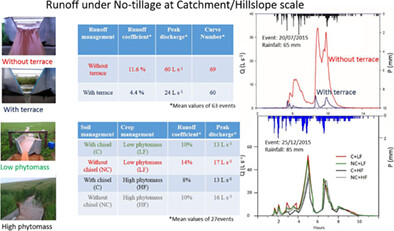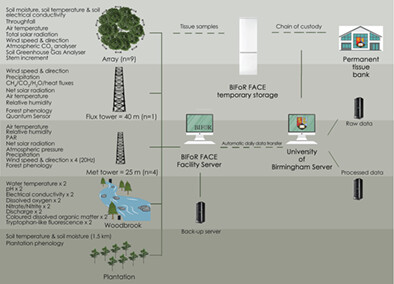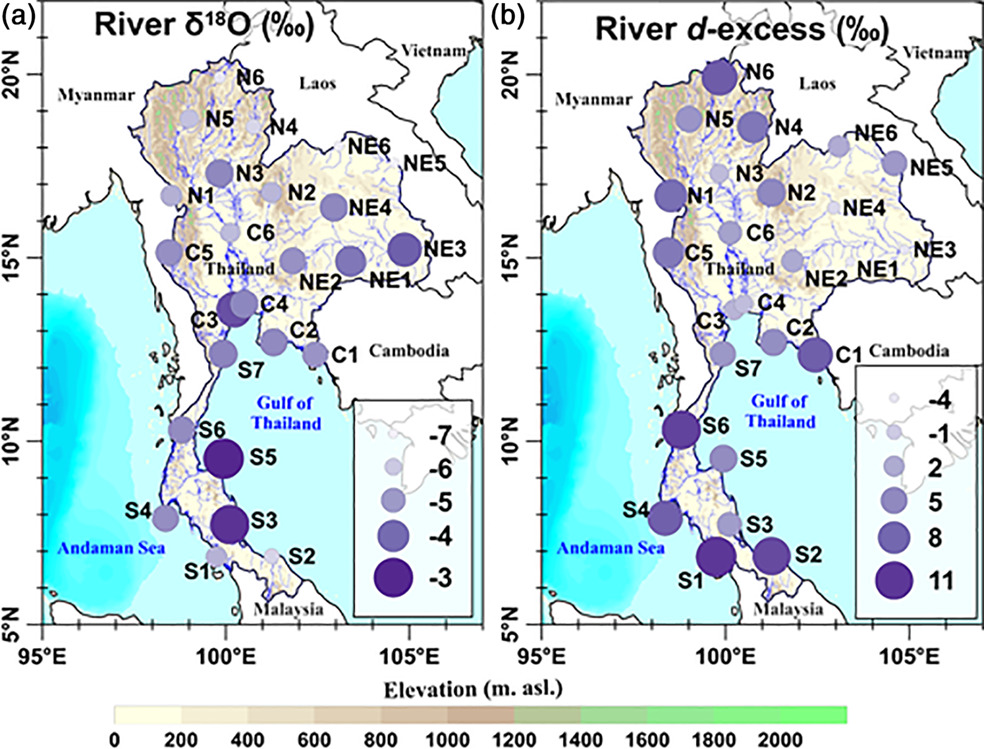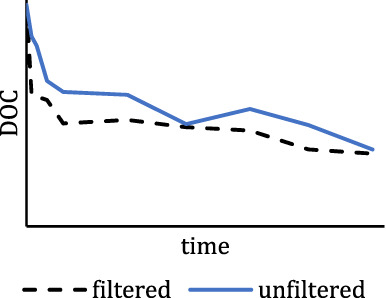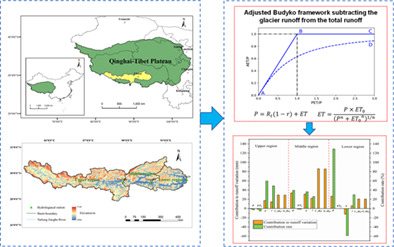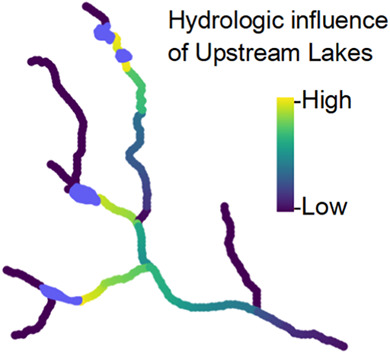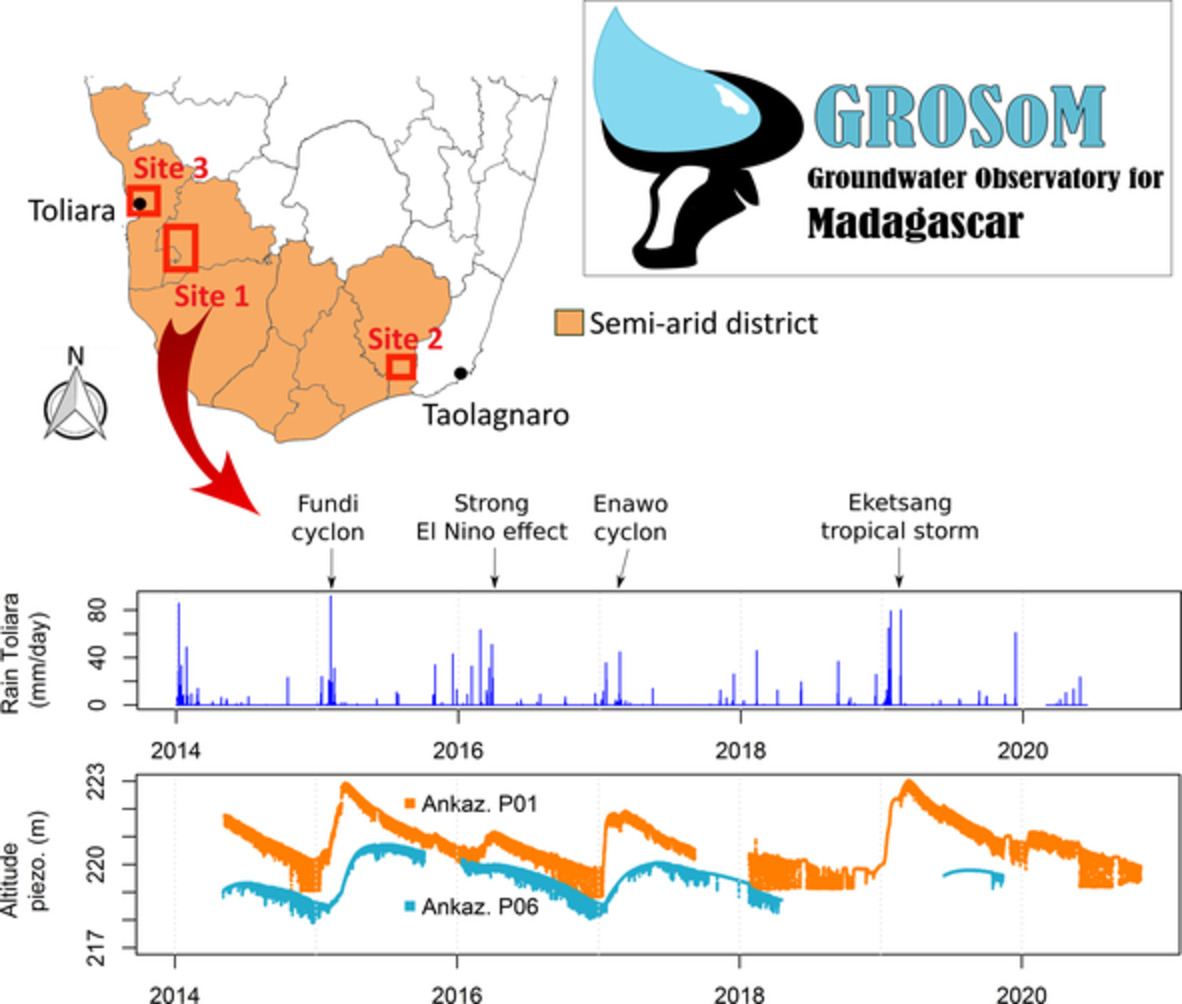Journal list menu
Export Citations
Download PDFs
ISSUE INFORMATION
WILDFIRE AND HYDROLOGICAL PROCESSES
Hydrological regimes in a tropical valley of New Caledonia (SW Pacific): Impacts of wildfires and invasive fauna
- First Published: 01 February 2021
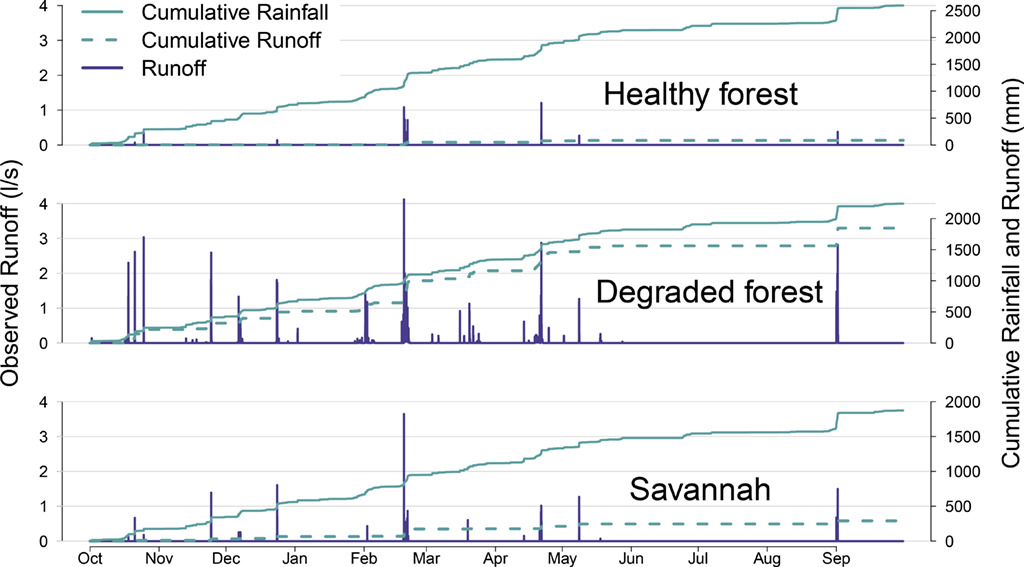
Striking differences in runoff properties are found in experimental plots located in characteristic land surfaces in the North East New Caledonia. Annual runoff coefficients are in the range of 0.28–0.82 for a forest degraded by invasive mammals (deer and wild pigs), 0.06–0.16 for a woody savannah, and 0.01–0.03 for a healthy forest. It is proposed that arrangement of these three land surfaces in the landscape may control runoff properties at the scale of a watershed.
RESEARCH AND OBSERVATORY CATCHMENTS: THE LEGACY AND THE FUTURE
Sources of variability in springwater chemistry in Fool Creek, a high-elevation catchment of the Rocky Mountains, Colorado, USA
- First Published: 14 February 2021
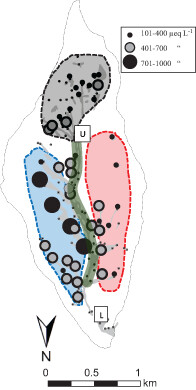
Emergent groundwater springs (dots) and associated wetlands (gray shading) in the Fool Creek catchment at the Fraser Experimental Forest, Colorado. The chemical composition of springwater reflected distinct groundwater sources and varied with elevation and among catchment zones. Acid neutralizing capacity (see Figure) and other inorganic constituents were more concentrated in springwater emerging from several springs in a geologically faulted portion of the catchment, and these had a predominant effect on downstream ion concentrations.
Hydrological and meteorological data from research catchments at the Marcell Experimental Forest, Minnesota, USA
- First Published: 14 February 2021
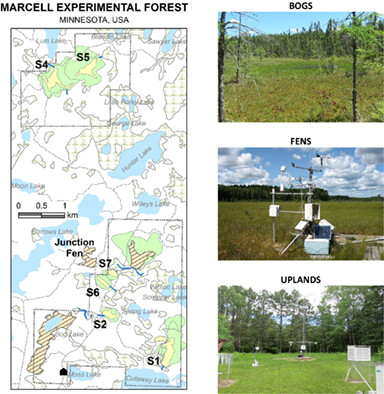
Monitoring at the Marcell Experimental Forest (MEF) catchments in northern Minnesota, USA, is unique from typical mountainous research catchments. We provide an overview of available data and metadata that are archived and available through community repositories. The research programme fills an important role in environmental monitoring and research on hydrology, ecology, biogeochemistry, and environmental change.
Quantifying the impact of no-till on runoff in southern Brazil at hillslope and catchment scales
- First Published: 16 February 2021
Observing the critical zone on a critical budget: The Peri Lake experimental catchment
- First Published: 13 February 2021
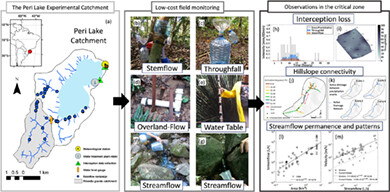
We use a combination of low-cost and low-technology with traditional methods to measure the major components of the water balance of the Peri Lake Experimental Catchment, a 20 km2 subtropical coastal lake catchment in Southern Brazil. (a) Location of monitoring sites and instrumentation. (b, c) Rainfall interception equipment. (d, e) Overland flow detector and groundwater level equipment. (f, g) Streamflow measurements. (h, i) Rainfall interception patterns. (j, k) Overland flow observation and active drainage network. (l, m) Baseflow and velocity scaling relationships.
Biogeochemical responses over 37 years to manipulation of phosphorus concentrations in an Arctic river: The Upper Kuparuk River Experiment
- First Published: 03 February 2021
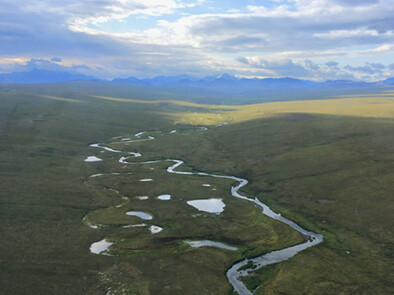
This paper summarizes findings from 37 years of monitoring of an Arctic tundra river, including results from the longest known experimental nutrient enrichment of any river. The study documented notable trends (e.g., increasing nitrate, decreasing organic phosphorus) that would have been difficult or impossible to identify from short-term studies. It also substantiated conclusions from earlier, short-term experiments. The project has informed numerous stream catchment studies in the Arctic and beyond.
A critical zone observatory dedicated to suspended sediment transport: The meso-scale Galabre catchment (southern French Alps)
- First Published: 11 February 2021
A community-supported weather and soil moisture monitoring database of the Roaring Fork catchment of the Colorado River Headwaters
- First Published: 09 February 2021
BIFoR FACE: Water–soil–vegetation–atmosphere data from a temperate deciduous forest catchment, including under elevated CO2
- First Published: 17 February 2021
Long-term hydrological, biogeochemical, and climatological data from Walker Branch Watershed, East Tennessee, USA
- First Published: 24 February 2021
The Kiryu Experimental Watershed: 50-years of rainfall-runoff data for a forest catchment in central Japan
- First Published: 24 February 2021
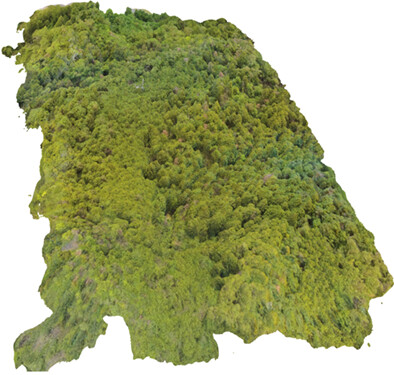
- Research in the Kiryu Experimental Catchment (KEW) began in 1967 to elucidate the hydrological and biogeochemical processes in the forested catchment in relation to climate, geology, soil, and vegetation growth.
- The ratio of annual direct runoff to precipitation, as well as the sediment transport, was larger in the last decade in response to the rainfall patterns.
- Our data presented here suggest that a close relationship exists between the climate condition, rainfall-runoff response, sediment dynamics, as well as a slowly progressing change of forest condition.
Long-term ecosystem and biogeochemical research in Loch Vale watershed, Rocky Mountain National Park, Colorado
- First Published: 24 February 2021
Ressi experimental catchment: Ecohydrological research in the Italian pre-Alps
- First Published: 17 February 2021
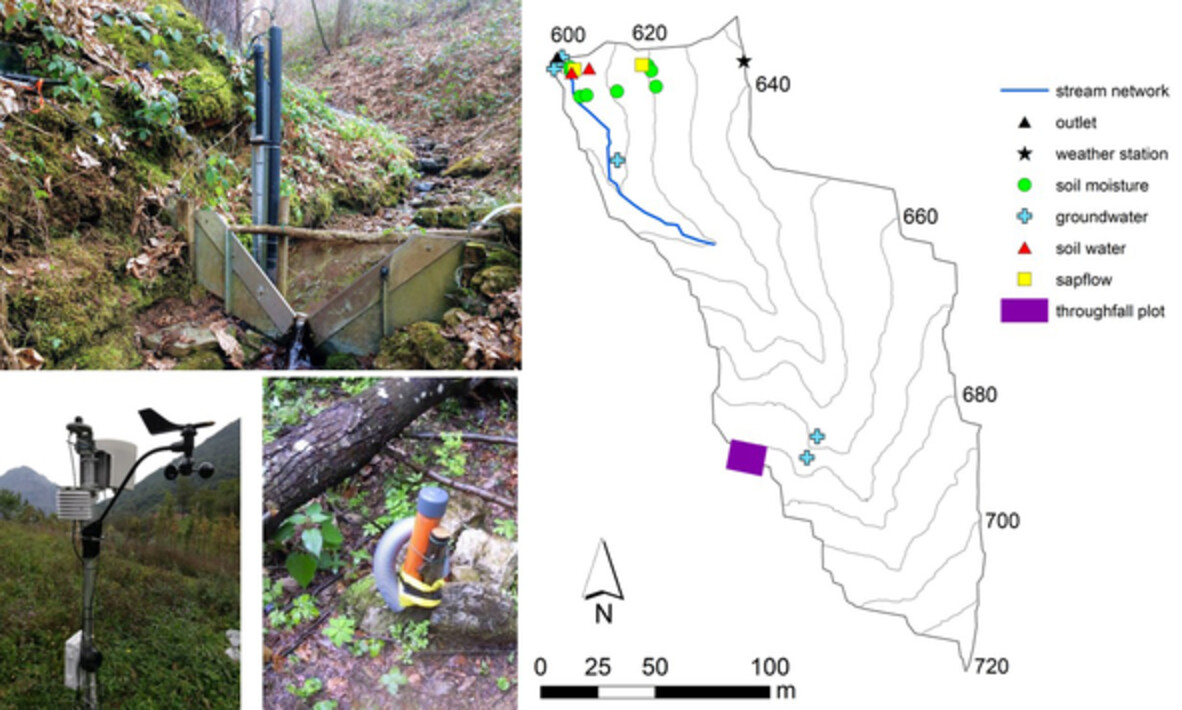
Ressi is a small forested catchment located in the Italian pre-Alps. The site became an experimental catchment to investigate the water fluxes in the soil–plant–atmosphere continuum and the impact of vegetation on runoff generation in 2012. The field set up includes measurements of the rainfall, streamflow, soil moisture at various depths, and depth to water table. Precipitation, stream water, shallow groundwater, soil water, and plant water are sampled for tracer analysis.
Stream discharge and water quality data for East Fork Poplar Creek beginning 2012
- First Published: 24 February 2021
This data note describes 15-minute discharge and in-situ water quality data at two locations along East Fork Poplar Creek in east Tennessee, USA. The goal of this data collection is to improve understanding of watershed functions, hydrologic dynamics, and material flux. The data will contribute to site conceptual and numerical models, exposure and risk evaluation, remediation selection and design, and performance monitoring. The publicly available data can be accessed via unique url or DOI.
RESEARCH ARTICLES
Spatiotemporal dynamics of water sources in a mountain river basin inferred through δ2H and δ18O of water
- First Published: 27 January 2021
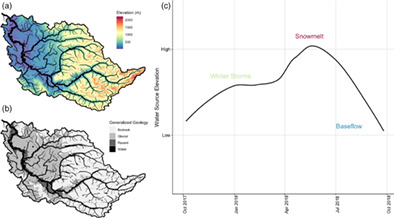
Water sources in a mountain river were evaluated using stable isotopes of water. Stable isotope ratios varied strongly with mean watershed elevation. Depleted isotope in spring reflect snowmelt moving quickly through the watershed, and enriched summer isotope ratios suggest that groundwater is sourced from low elevation areas and recharged by winter precipitation. Our results suggest that baseflow in the Snoqualmie River may be relatively resilient to predicted warming and subsequent changes to snowpack in the Pacific Northwest.
Isotopic temporal and spatial variations of tropical rivers in Thailand reflect monsoon precipitation signals
- First Published: 01 February 2021
Estimating water balance components in irrigated agriculture using a combined approach of soil moisture and energy balance monitoring, and numerical modelling
- First Published: 04 February 2021
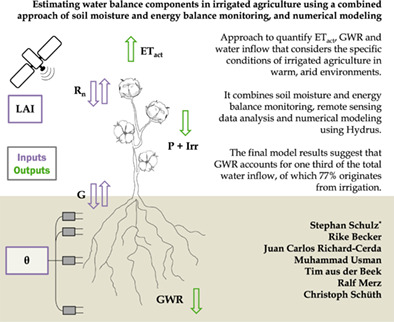
Approach to quantify ETact, GWR and water inflow that considers the specific conditions of irrigated agriculture in warm, acid environments. It combines soil moisture and energy balance monitoring, remote sensing data analysing data analysis and numerical modelling using Hydrus. The final model results suggest that GWR accounts for one third of the total water inflow, of which 77% originates from irrigations.
Towards understanding organic matter fluxes and reactivity in surface waters: Filtering impact on DOC and POC degradation
- First Published: 01 February 2021
Evaluation of the temporal variations of groundwater storage and its interactions with climatic variables using GRACE data and hydrological models: A study from Turkey
- First Published: 04 February 2021
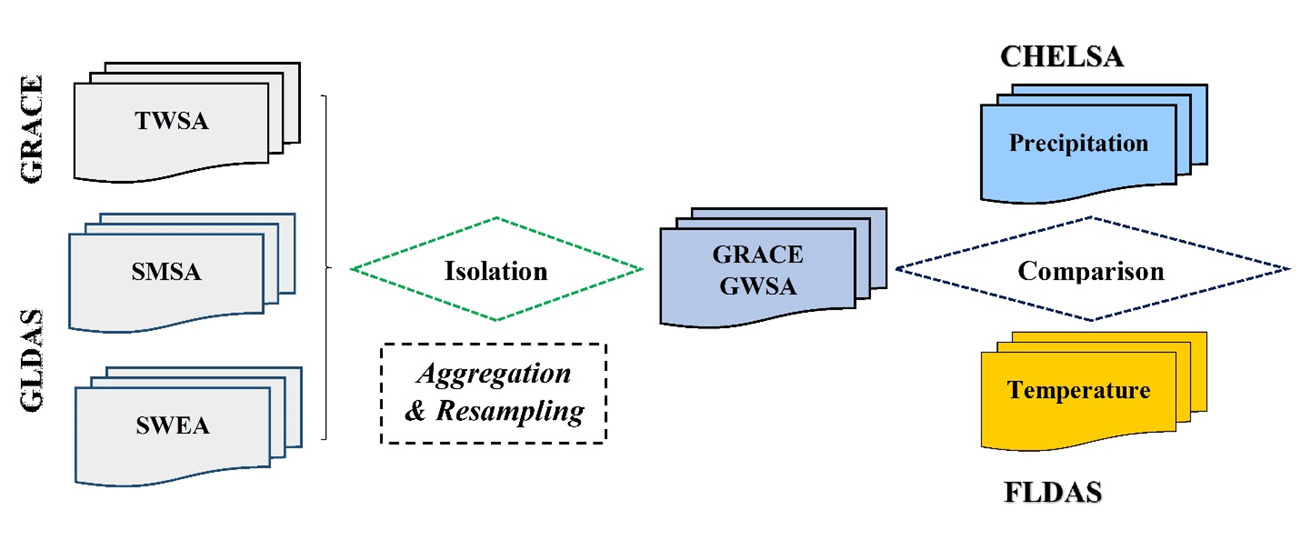
The results suggest that there is a descending trend for TWSA and GWSA over Turkey with a total loss of 11 and 6 cm respectively. The statistical analysis results also indicate that the monthly variations of GWS over Turkey are highly correlated with precipitation and more strongly with temperature at 2-month lag. The analysis of the climatology (long-term) values of monthly GWSA, precipitation and temperature also revealed high agreement between the variables.
An improved practical approach for estimating catchment-scale response functions through wavelet analysis
- First Published: 09 February 2021
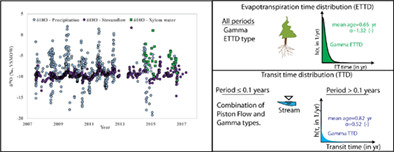
- Novel approaches are proposed for estimating catchment-scale transit time (TTD) and evapotranspiration time (ETTD) distributions with a case study application to a mountain headwater catchment.
- Composite TTDs best matched the observations for periods up to approximately 1 month, but a Gamma TTD was most appropriate thereafter and most accurately described ETTD at all timescales.
- The proposed approaches are computationally inexpensive, robust to moderate gaps in input data, and thus broadly applicable to mountain and/or seasonally dry catchments worldwide.
Variation and attribution of water use efficiency in sunflower and maize fields in an irrigated semi-arid area
- First Published: 06 February 2021
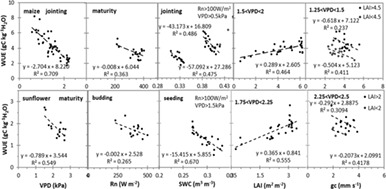
In this study, water-carbon fluxes were measured using eddy covariance systems in two irrigated farmlands (sunflower and maize) in arid area of China to examine water use efficiency (WUE) of maize and sunflower and its responses to both environmental and physiological factors. We found vapour pressure deficit (VPD) was the most important factor restricting WUE of sunflower and maize. Abundant soil moisture with irrigation and shallow groundwater contributes to the negative correlation between soil moisture and WUE. The impact of crop leaf area index (LAI) and canopy conductance (gc) to WUE depend on VPD ranges.
Quantifying the contribution of climate and underlying surface changes to alpine runoff alterations associated with glacier melting
- First Published: 01 February 2021
Surface water-groundwater exchange dynamics in buried-valley aquifer systems
- First Published: 29 January 2021

The response of surface water-groundwater exchange processes in glacial aquifers to sediment heterogeneity and hydrologic hot moments are critically evaluated using spectral and flow pattern analyses. Results indicate that significant flows during storms alter groundwater flow patterns, even between consecutive storm events, and that sediment heterogeneity strongly controls the magnitude of flow and solute transport.
Describing alpine lake influence on stream network temperatures: A statistical modelling approach
- First Published: 01 February 2021
Variability of stream extents controlled by flow regime and network hydraulic scaling
- First Published: 07 February 2021
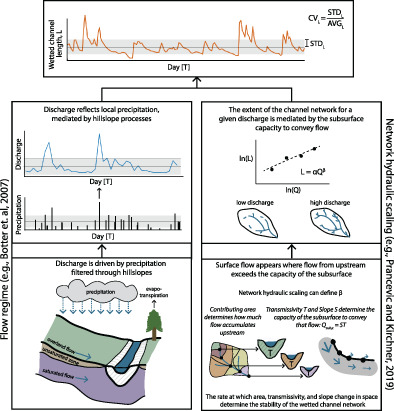
This study presents a quantitative, conceptual framework to explore how flow regime and stream network hydraulic scaling factors co-determine the relative temporal variability in wetted channel drainage density, L. Although we find that variability in L is universally damped relative to variability in streamflow (Q), the relationship is elastic, meaning that for a given increase in the variability in Q, headwater catchments will experience greater-than-proportional increases in the variability of L, making headwater catchments particularly vulnerable to climate change.
The effect of hedgerow wild-margins on topsoil hydraulic properties, and overland-flow incidence, magnitude and water-quality
- First Published: 18 February 2021

This manuscript is the first globally to quantify changes to overland-flow (incidence, magnitude and water-quality) induced by a hedgerow wild-margin within a grassland landscape through direct field-based observations as well as subsequent modelling. This fills a substantial knowledge gap within the hydrological understanding of hedgerows, as well as improves the understanding of runoff generation processes within agricultural catchments.
Hydraulic properties affected by litter and stem cover under overland flow
- First Published: 14 February 2021
Exploring the stemflow dynamics and driving factors at both inter- and intra-event scales in a typical subtropical deciduous forest
- First Published: 14 February 2021
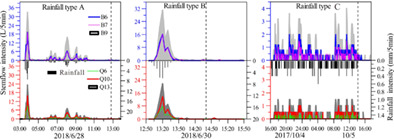
- Effects of tree species and meteorological factors on stemflow generation depend on rainfall type.
- Under rainfall types with high amount and high intensity, stemflow intensity has a significant positive correlation with rainfall intensity at the 5-min interval scale.
- The lag time between the start of rainfall and stemflow under high-intensity, short-duration rainfall type is the shortest, while the duration of stemflow after rain cessation under high-amount, long-duration rainfall type is the largest (maximum 4.3 h).
Evaluating soil water routing approaches in watershed-scale, ecohydrologic modelling
- First Published: 06 January 2021
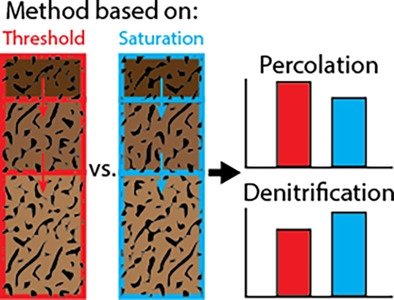
The impacts of modifying a threshold-based to a relative saturation-based soil water modelling approach was tested for the Soil and Water Assessment Tool. Differences in approach led to a regime shift in percolation from a few, high magnitude events to frequent, low magnitude events. Changes directly impacted the water balance and a range of biophysical predictions.
A detailed energy budget analysis of river supercooling and the importance of accurately quantifying net radiation to predict ice formation
- First Published: 20 January 2021
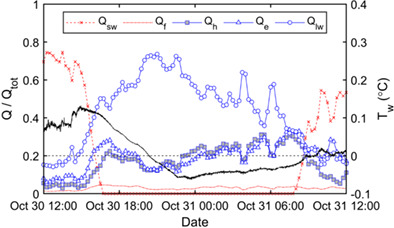
The heat budget of a moderately sized river is analysed throughout the supercooling process during river freeze-up. Individual heat fluxes are quantified and their relative significance during six individual supercooling events is highlighted, with a focus on the significance of outgoing longwave radiation. Several different equations for calculating the latent and sensible surface fluxes are compared and specific equations are recommended for use on daily and sub-daily timescales.
Sap flow and plant water sources for typical vegetation in a subtropical humid karst area of southwest China
- First Published: 14 February 2021
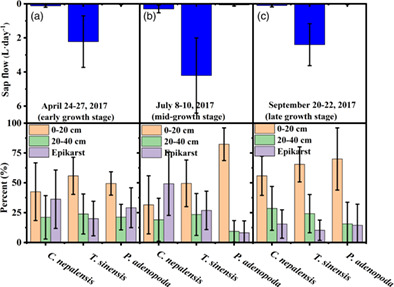
- Toona Sinensis (3.89 ± 3.87 L·day−1) had significantly higher daily sap flow than Coriaria nepalensis (0.33 ± 0.37 L·day−1) and Populus adenopoda (0.09 ± 0.12 L·day−1);
- Over the entire study period, plants mainly used water from the surface soil horizons;
- A greater proportion of epikarst water was used for Coriaria nepalensis than by Toona sinensis and P. adenopoda over the whole growth stage, and more epikarst water was used in early and mid-growth stages compared to the late stage for the three species
Identifying surface water evaporation loss of inland river basin based on evaporation enrichment model
- First Published: 16 February 2021
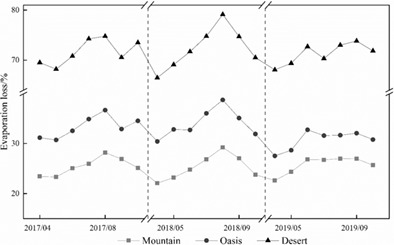
- The evaporation enrichment of surface water is higher in summer, lower in autumn, higher in deserts and lower in mountains.
- The higher the temperature, the greater the evaporation loss; the higher the air humidity, the greater the evaporation loss.
- The construction of reservoirs and farmland irrigation will also increase the evaporation loss.
Effects of pipe outlet blocking on hydrological functioning in a degraded blanket peatland
- First Published: 23 February 2021
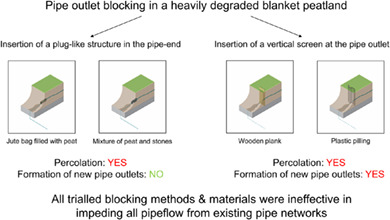
Blocking of pipe outlets in a heavily degraded UK blanket bog led to new pipe outlets appearing or seepage occurring around blocks within 90 days of blocking. Two pipes at head locations contributed more to streamflow compared to two pipes at edge locations, altogether they accounted for 11.3 % of streamflow. The degree of water-table drawdown in gully edges is thought to relate to piping activity. Peatland practitioners should consider control measures that reduce pipeflow further upslope of pipe outlets.
A full-scale study of Darcy-Weisbach friction factor for channels vegetated by riparian species
- First Published: 15 December 2020
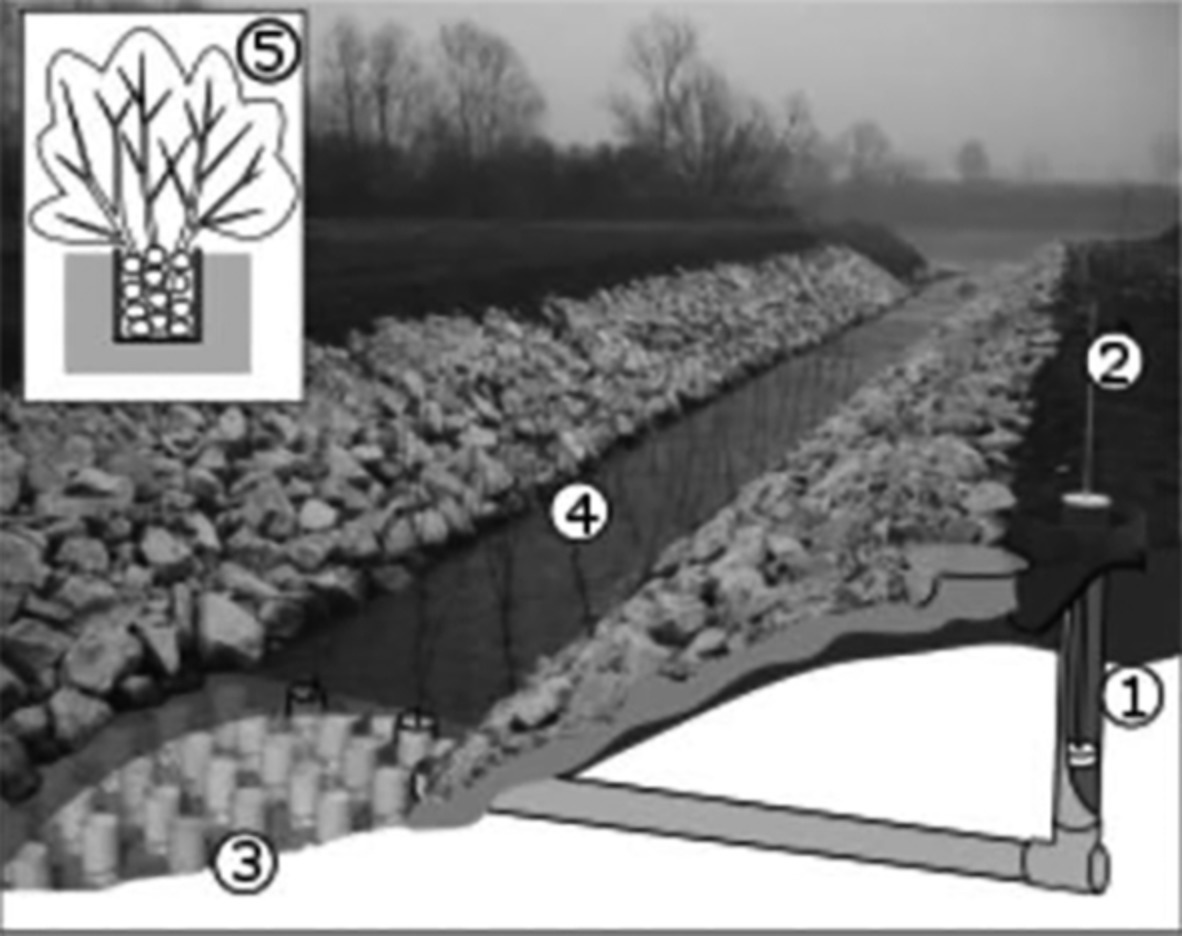
A theoretical flow resistance equation for open channel flow was tested using flow measurements carried out in a channel equipped with three types of riparian plants (Salix alba L., Salix caprea L. and Alnus glutinosa L.). Experimental runs were carried out with no vegetation and for nine vegetated conditions. The flow resistance law, coupled with the relationship for estimating the Γ function of the velocity profile having a scaling factor different for each investigated vegetation type, allowed an accurate estimate of the Darcy-Weisbach friction factor. The analysis of the vegetation species with few leaves or leafless demonstrated that the scaling factor of the Γ function resulted strongly related to the bending stiffness.
Analysis of seasonal snowmelt contribution using a distributed energy balance model for a river basin in the Altai Mountains of northwestern China
- First Published: 18 January 2021
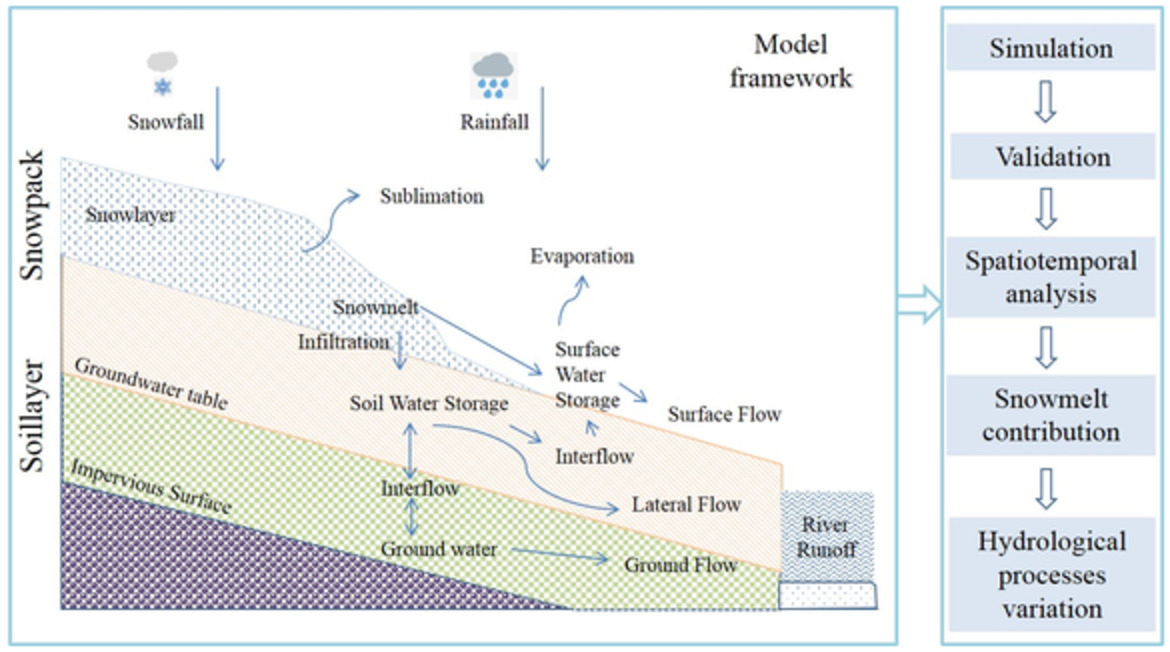
- Geomorphology-based ecohydrological model (GBEHM) model is introduced to study snowmelt and runoff dynamics in an alpine river basin
- We quantitatively analysed snowmelt contributions to hydrological processes
- Seasonal variation in snowmelt's hydrological contributions were detected
- Annual snowfall, snowmelt, snow evaporation and sublimation differ by elevation
- GBEHM model has potential applicability in other high-elevation regions that get seasonal snow cover
Temporal dynamics of evapotranspiration in semiarid native forests in Brazil and Spain using remote sensing
- First Published: 01 February 2021

Actual evapotranspiration increases more rapidly in Pinares than in the Caatinga. Taking Caatinga as a hydrological mirror, some consequences are expected to Pinares, such as significant changes in the water balance, increase of biodiversity vulnerability and reduction of water availability in soil and reservoirs.
Assessing the effects of forest biomass reductions on forest health and streamflow
- First Published: March 2021

We developed a new vegetation-change water-balance approach to examine the effects of biomass reductions on forest health and streamflow. During dry periods, most of the water made available from biomass reductions was partitioned to transpiration of the remaining trees. During wet periods, this partitioning shifted to streamflow.
SCIENTIFIC BRIEFING
On the use of leaf water to determine plant water source: A proof of concept
- First Published: 03 February 2021
INVITED COMMENTARIES
Non-stationary control of the NAO on European rainfall and its implications for water resource management
- First Published: 19 February 2021
DATA NOTES
Long-term groundwater resource observatory for Southwestern Madagascar
- First Published: 24 February 2021
HPEYE
The impact of morphodynamics and storm floods on pore water flow and transport in the subterranean estuary
- First Published: 10 March 2021





